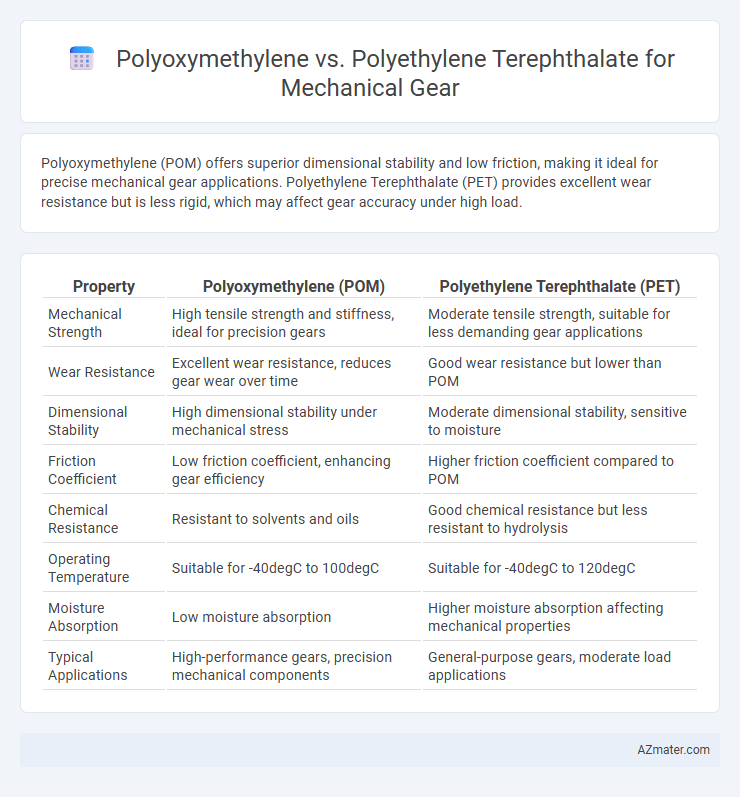Polyoxymethylene (POM) offers superior dimensional stability and low friction, making it ideal for precise mechanical gear applications. Polyethylene Terephthalate (PET) provides excellent wear resistance but is less rigid, which may affect gear accuracy under high load.
Table of Comparison
| Property | Polyoxymethylene (POM) | Polyethylene Terephthalate (PET) |
|---|---|---|
| Mechanical Strength | High tensile strength and stiffness, ideal for precision gears | Moderate tensile strength, suitable for less demanding gear applications |
| Wear Resistance | Excellent wear resistance, reduces gear wear over time | Good wear resistance but lower than POM |
| Dimensional Stability | High dimensional stability under mechanical stress | Moderate dimensional stability, sensitive to moisture |
| Friction Coefficient | Low friction coefficient, enhancing gear efficiency | Higher friction coefficient compared to POM |
| Chemical Resistance | Resistant to solvents and oils | Good chemical resistance but less resistant to hydrolysis |
| Operating Temperature | Suitable for -40degC to 100degC | Suitable for -40degC to 120degC |
| Moisture Absorption | Low moisture absorption | Higher moisture absorption affecting mechanical properties |
| Typical Applications | High-performance gears, precision mechanical components | General-purpose gears, moderate load applications |
Introduction to Polyoxymethylene and Polyethylene Terephthalate
Polyoxymethylene (POM) is a highly crystalline thermoplastic known for its excellent mechanical strength, low friction, and high dimensional stability, making it ideal for precision mechanical gears. Polyethylene Terephthalate (PET) offers good toughness, chemical resistance, and thermal stability, but typically exhibits lower wear resistance and mechanical strength compared to POM. The choice between POM and PET for mechanical gears depends on specific application requirements such as load capacity, operating temperature, and exposure to chemicals.
Material Composition and Structure Comparison
Polyoxymethylene (POM), a highly crystalline thermoplastic with a linear polymer chain and strong covalent bonds, offers excellent dimensional stability, low friction, and high mechanical strength ideal for mechanical gears. Polyethylene Terephthalate (PET) consists of semi-crystalline polyester formed by polymerizing ethylene glycol and terephthalic acid, providing good stiffness, impact resistance, and moderate wear resistance but lower mechanical strength compared to POM. The dense, tightly packed molecular structure of POM results in superior wear resistance and fatigue strength, while PET's more flexible ester linkages contribute to its slightly reduced rigidity and dimensional stability under load.
Mechanical Strength and Durability
Polyoxymethylene (POM) offers superior mechanical strength and wear resistance compared to Polyethylene Terephthalate (PET), making it ideal for high-stress mechanical gear applications. POM exhibits excellent tensile strength, low friction coefficient, and high stiffness, which contribute to enhanced durability under repetitive load conditions. While PET provides good chemical resistance and toughness, it generally falls short in long-term mechanical performance and dimensional stability when subjected to continuous mechanical stress.
Wear Resistance in Gear Applications
Polyoxymethylene (POM) offers superior wear resistance compared to Polyethylene Terephthalate (PET) in mechanical gear applications due to its high crystallinity and low coefficient of friction, which reduce surface degradation under load. POM's molecular structure provides excellent dimensional stability and fatigue resistance, making it ideal for gears subjected to repeated stress and sliding contact. PET, while possessing good strength and chemical resistance, typically exhibits higher wear rates and less durability under continuous mechanical friction in gear systems.
Dimensional Stability and Precision
Polyoxymethylene (POM) offers superior dimensional stability and precision compared to Polyethylene Terephthalate (PET) when used in mechanical gears, due to its low moisture absorption and minimal thermal expansion. POM's high crystallinity and rigidity ensure consistent gear geometry under mechanical stress, enhancing performance in high-precision applications. In contrast, PET exhibits higher hygroscopicity and thermal sensitivity, which can lead to dimensional variations and reduced gear accuracy over time.
Friction and Lubrication Requirements
Polyoxymethylene (POM) exhibits superior low friction and excellent wear resistance compared to Polyethylene Terephthalate (PET), making it ideal for mechanical gears requiring minimal lubrication. POM's intrinsic self-lubricating properties reduce the need for additional lubricants, enhancing gear longevity and performance in high-speed applications. PET, while offering good mechanical strength, demands more frequent lubrication due to higher friction coefficients and increased wear under load.
Thermal Performance and Operating Temperature Range
Polyoxymethylene (POM) exhibits superior mechanical strength and dimensional stability compared to Polyethylene Terephthalate (PET), with a higher melting point around 175degC, allowing consistent performance in operating temperatures up to 120degC. PET operates effectively within a lower temperature range, typically up to 80-100degC, but offers better resistance to hydrolysis and UV exposure under high thermal stress. The choice between POM and PET for mechanical gears hinges on the required thermal durability and environment, with POM favored for higher temperature applications and PET for scenarios demanding chemical and environmental stability.
Chemical Resistance and Environmental Suitability
Polyoxymethylene (POM) exhibits superior chemical resistance to solvents, fuels, and alkalis, making it ideal for mechanical gears exposed to harsh environments where durability is critical. Polyethylene Terephthalate (PET) offers moderate chemical resistance but can degrade faster in acidic or alkaline conditions, limiting its use in chemically aggressive applications. Environmentally, POM has a higher melting point and better resistance to wear in abrasive settings, while PET, being more recyclable and biodegradable, provides enhanced environmental sustainability for gears with less demanding chemical exposure.
Cost-Effectiveness and Manufacturability
Polyoxymethylene (POM) offers superior dimensional stability and lower friction, making it highly effective for mechanical gears, while polyethylene terephthalate (PET) provides better chemical resistance but lower wear performance. POM's lower mold shrinkage and ease of precision machining enhance manufacturability, reducing production cycle times and tooling costs compared to PET. Cost-effectiveness favors POM in high-volume gear manufacturing due to its durability and lower post-processing requirements.
Conclusion: Best Choice for Mechanical Gear Applications
Polyoxymethylene (POM) offers superior dimensional stability, low friction, and excellent wear resistance, making it ideal for precision mechanical gears operating under high stress and continuous motion. Polyethylene Terephthalate (PET) provides good chemical resistance and moderate strength but falls short of POM's mechanical endurance and low creep characteristics. For demanding mechanical gear applications requiring high durability and accuracy, Polyoxymethylene is the best choice.

Infographic: Polyoxymethylene vs Polyethylene Terephthalate for Mechanical Gear
 azmater.com
azmater.com